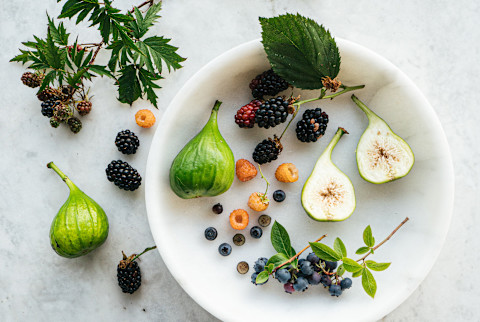This Functional Nutritionist Says "Smaller" Foods Have Giant Health Benefits

Less is more—that's how the saying goes, no? In the functional food space, the catchphrase certainly stands: The simpler the ingredient list (bonus points if you're eating whole produce with no ingredient list at all), the more nutritional benefit you'll likely gain. Of course, there are some nuances, but plenty of experts inherently subscribe to the "simpler is better" philosophy.
But let's dive deeper into the phrase. According to Deanna Minich, Ph.D., IFMCP, a functional nutritionist who studies plant-based pigments, the size of your food matters, too. As she explains on the mindbodygreen podcast, in many cases, smaller foods may offer more nutrients.
Why Minich wants you to eat smaller foods.
"Keep in mind that when it comes to plants, smaller is usually better because [phytonutrients] are more concentrated," she shares. It's like all the nutrients you would get from a regular-size plant are jam-packed into one mini, adorable bulb. But that doesn't mean tiny blueberries are necessarily more nutrient-dense than, say, a pomegranate—rather, Minich draws the comparison from foods within the same phytonutrient family.
"So microgreens instead of the large collard leaf," she says. "That is going to give you greater nutrient density." And along with those tiny blueberries? "Get smaller wild berries," she adds, which some say are even richer in antioxidants. In fact, wild blueberries are one of the top fruit antioxidants, according to the Nutrient Data Laboratory from the U.S. Department of Agriculture, with two times the amount of antioxidants than regular blueberries. That's not to say you shouldn't eat the regular blues at all—they do have polyphenol power1, too—but it's interesting to know that smaller, wild berries pack such a punch.
As for the aforementioned microgreens, these tiny, peppery sprouts are chock-full of vitamins (like vitamin C, E, and K), and a 2014 study conducted by the USDA even tested 25 varieties of microgreens to see how their nutrients compared to other typical vegetables. The verdict? "In general, microgreens contained considerably higher levels of vitamins and carotenoids—about five times greater—than their mature plant counterparts, an indication that microgreens may be worth the trouble of delivering them fresh during their short lives," the report reads.
Again, that's not a reason to stop eating grown-up broccoli, of course, but it does give grounds for adding some baby broccoli sprouts to your grocery cart—these microgreens, in particular, contain a concentrated amount of compounds to boost the production of sulforaphane. And if you can't find them in store, you can even grow your own healthy sprouts (see how, here).
The takeaway.
Let us emphasize: Eating any plant is better than eating no plants at all—with a plant-rich diet, you're still consuming all those good-for-you phytonutrients. But if you do find wild blueberries (even frozen berries retain their nutrients, says Minich) or microgreens at your local market, you might want to consider snagging them, too. You may get more phytochemical bang for your buck.
